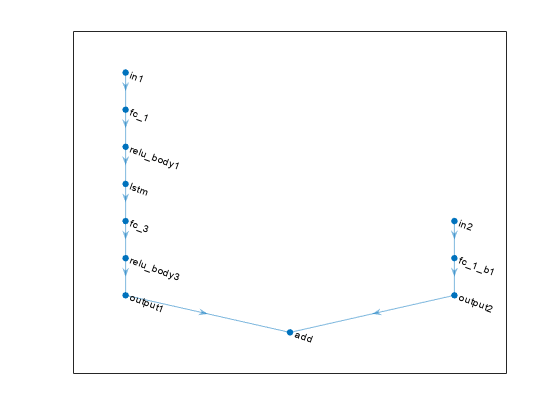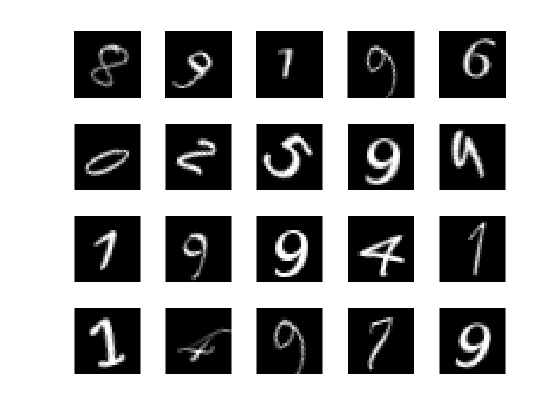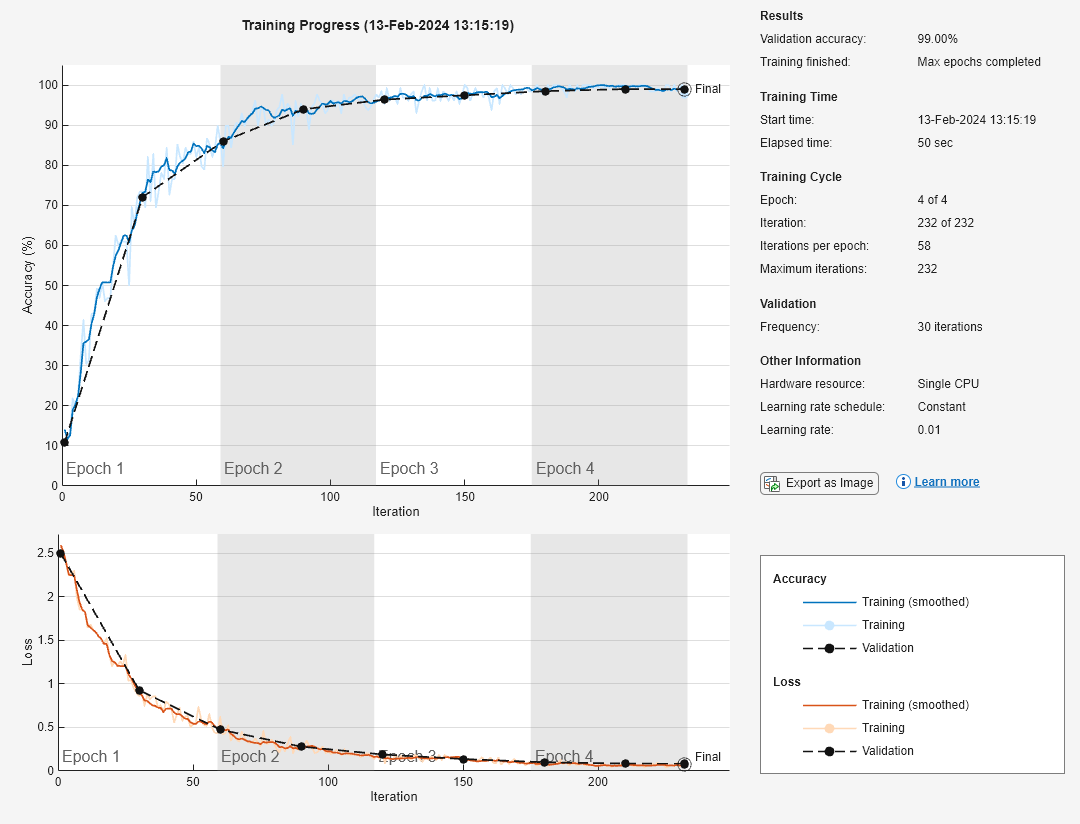Analyze Network for Code Generation
You can analyze code generation compatibility of deep learning networks by using the
analyzeNetworkForCodegen function. Use the network
code generation analyzer to validate a SeriesNetwork,
DAGNetwork, and dlnetwork for non-library and
library targets and detect problems before code generation. Supported library targets
include MKL-DNN, ARM Compute,
CMSIS-NN, ARM Compute Mali,
cuDNN, and TensorRT. Problems that
analyzeNetworkForCodegen detects include unsupported layers for code
generation, network issues, built-in layer specific issues, and issues with custom
layers.
The analyzeNetworkForCodegen function requires the MATLAB® Coder™ Interface for Deep Learning and GPU Coder™ Interface for Deep Learning support packages. To download and install support package, use the Add-On
Explorer. You can also download the support packages from MathWorks
GPU Coder Team and MathWorks
MATLAB Coder Team.
Check dlnetwork for Code Generation Compatibility
This example shows how to check code generation compatibility of multi-input dlnetwork by using the analyzeNetworkForCodegen function.
The example checks code generation support for the following targets:
Library free code generation.
ARM® Compute Library.
ARM Compute Library for Mali GPU.
Intel® Math Kernel Library for Deep Neural Networks (Intel MKL-DNN).
Common Microcontroller Software Interface Standard - Neural Network (CMSIS-NN) library.
NVIDIA® CUDA® Deep Neural Network library (cuDNN).
NVIDIA TensorRT high performance deep learning inference optimizer and run-time library.
Define Network Architecture
Construct a network with two branches. The network takes two inputs, with one input per branch. Connect the branches using an addition layer.
layersBranch1 = [
sequenceInputLayer(1,"Name","in1","Normalization","none")
fullyConnectedLayer(32,"Name","fc_1")
reluLayer("Name","relu_body1")
lstmLayer(32,"Name","lstm", "OutputMode","last")
fullyConnectedLayer(32,"Name","fc_3")
reluLayer("Name","relu_body3")
fullyConnectedLayer(4,"Name","output1")
additionLayer(2,"Name","add")];
layersBranch2 = [
imageInputLayer([5 5 3],"Name","in2","Normalization","none")
fullyConnectedLayer(4,"Name","fc_1_b1")
reluLayer("Name","output2")];
lgraph = layerGraph(layersBranch1);
lgraph = addLayers(lgraph, layersBranch2);
lgraph = lgraph.connectLayers('output2', 'add/in2');
figure
plot(lgraph)
Create the dlnetwork.
dlnet = dlnetwork(lgraph);
Analyze Network for Code Generation
Run the analyzeNetworkForCodegen function for mobilenetv2, specifying the target libraries to analyze. The analyzeNetworkForCodegen function requires the MATLAB® Coder™ Interface for Deep Learning and the GPU Coder™ Interface for Deep Learning support packages. To install the required support packages, use the Add-On Explorer.
targetLibraries = {'none','arm-compute','arm-compute-mali',...
'mkldnn','cmsis-nn','cudnn', 'tensorrt'};
S = analyzeNetworkForCodegen(dlnet,TargetLibrary = targetLibraries); Supported NetworkDiagnostics LayerDiagnostics
_________ ___________________________________________________________________________________________________________________________________________________________ _______________________________________________________________________________________________________________________________________________________________________________
none "Yes" "" ""
arm-compute "Yes" "" ""
arm-compute-mali "No" "Found 1 issue(s). View network diagnostics." "Found 2 unsupported layer types. View incompatible layer types."
mkldnn "Yes" "" ""
cmsis-nn "No" "Found 1 issue(s). View network diagnostics." "Found 2 unsupported layer types. View incompatible layer types."
cudnn "Yes" "" ""
tensorrt "Yes" "" ""
Display the layer diagnostics for CMSIS-NN code generation.
S(5).LayerDiagnostics
ans=4×3 table
LayerName LayerType Diagnostics
____________ _______________ _________________________
"add" "AdditionLayer" "Unsupported layer type."
"relu_body1" "ReLULayer" "Unsupported layer type."
"relu_body3" "ReLULayer" "Unsupported layer type."
"output2" "ReLULayer" "Unsupported layer type."
Display the network diagnostics for CMSIS-NN code generation.
S(5).NetworkDiagnostics.Diagnostics
ans = "Code generation for cmsis-nn library does not support dlnetwork objects with combinations of sequence and non-sequence input layers. "
Analyze Classification Network for Code Generation Compatibility
This example shows how to create a simple convolutional neural network for deep learning classification and test the network for code generation compatibility. The example demonstrates how to:
Load and explore image data.
Define the network architecture.
Specify training options and train the network.
Predict the labels of new data and calculate the classification accuracy.
Analyze the deep learning network for code generation and report network and layer compatibility issues by using
analyzeNetworkForCodegen.
The analyzeNetworkForCodegen function requires the MATLAB® Coder™ Interface for Deep Learning and the GPU Coder™ Interface for Deep Learning support packages. To install the required support packages, use the Add-On Explorer.
Load and Explore Image Data
Load the digit sample data as an image datastore. Display some of the images in the datastore.
digitDatasetPath = fullfile(matlabroot,'toolbox','nnet','nndemos', ... 'nndatasets','DigitDataset'); imds = imageDatastore(digitDatasetPath, ... 'IncludeSubfolders',true,'LabelSource','foldernames'); figure; perm = randperm(10000,20); for i = 1:20 subplot(4,5,i); imshow(imds.Files{perm(i)}); end

Check the size of the first image in digitData. Each image is 28-by-28-by-1 pixels.
img = readimage(imds,1); size(img)
ans = 1×2
28 28
Divide the data into training and validation data sets, so that each category in the training set contains 750 images, and the validation set contains the remaining images from each label.
numTrainFiles = 750;
[imdsTrain,imdsValidation] = splitEachLabel(imds,numTrainFiles,'randomize');Define Network Architecture
Define the convolutional neural network architecture.
layers = [
imageInputLayer([28 28 1])
convolution2dLayer(3,8,'PaddingValue',5,'Name','conv1')
batchNormalizationLayer
reluLayer
maxPooling2dLayer(2,'Stride',2)
convolution2dLayer(3,16,'Padding','same','Name','conv2')
batchNormalizationLayer
reluLayer
maxPooling2dLayer(2,'Stride',2)
convolution2dLayer(3,32,'Padding','same','Name','conv3')
batchNormalizationLayer
reluLayer
fullyConnectedLayer(10)
softmaxLayer
classificationLayer];Specify Training Options and Train Network
Train the network using stochastic gradient descent with momentum (SGDM) with an initial learning rate of 0.01. Set the maximum number of epochs to 4. Monitor the network accuracy during training by specifying validation data and validation frequency. Shuffle the data every epoch. Turn on the training progress plot, and turn off the command window output.
options = trainingOptions('sgdm', ... 'InitialLearnRate',0.01, ... 'MaxEpochs',4, ... 'Shuffle','every-epoch', ... 'ValidationData',imdsValidation, ... 'ValidationFrequency',30, ... 'Verbose',false, ... 'Plots','training-progress');
Train the network using the architecture defined by layers, the training data, and the training options. The training progress plot shows the mini-batch loss and accuracy and the validation loss and accuracy.
net = trainNetwork(imdsTrain,layers,options);

Classify Validation Images and Compute Accuracy
Predict the labels of the validation data using the trained network, and calculate the final validation accuracy. Accuracy is the fraction of labels that the network predicts correctly. In this case, more than 99% of the predicted labels match the true labels of the validation set.
YPred = classify(net,imdsValidation); YValidation = imdsValidation.Labels; accuracy = sum(YPred == YValidation)/numel(YValidation)
accuracy = 0.9904
Analyze Network for Code Generation
To check the network for code generation compatibility, run analyzeNetworkForCodegen. By default, the function validates against a set of default CPU and GPU deep learning library targets. analyzeNetworkForCodegen returns a 1-by-N structure containing the analysis results.
S = analyzeNetworkForCodegen(net)
Supported LayerDiagnostics
_________ _______________________________________________________________________________________________________________________________________________________________________
none "No" "Found 1 issue(s) in 1 layer(s). View layer diagnostics."
arm-compute "No" "Found 1 issue(s) in 1 layer(s). View layer diagnostics."
mkldnn "No" "Found 1 issue(s) in 1 layer(s). View layer diagnostics."
cudnn "No" "Found 1 issue(s) in 1 layer(s). View layer diagnostics."
tensorrt "No" "Found 1 issue(s) in 1 layer(s). View layer diagnostics."
S=1×5 struct array with fields:
TargetLibrary
Supported
NetworkDiagnostics
LayerDiagnostics
IncompatibleLayerTypes
To view the layer issues in the network for the cuDNN target, use the following command. Alternatively, you can click on the View layer diagnostics hyperlink to display the layer issues.
S(4).LayerDiagnostics
ans=1×3 table
LayerName LayerType Diagnostics
_________ ____________________ _______________________________________________________________________________________________________________________________________________
"conv1" "Convolution2DLayer" "Layer 'conv1' has a non-default padding value. Code generation for nnet.cnn.layer.Convolution2DLayer only supports padding value equal to 0. "
The first convolution2dLayer (conv1) has non-zero padding value. For code generation, the PaddingValue parameter must be equal to 0, which is the default value.
Fix Network Issues and Retrain
In this example, the padding value of the convolution layer can be set to zero.
layers(2) = convolution2dLayer(3,8,'PaddingValue',0,'Name','conv1');
Retrain the modified network using the following training options.
options = trainingOptions('sgdm', ... 'InitialLearnRate',0.01, ... 'MaxEpochs',4, ... 'Shuffle','every-epoch', ... 'ValidationData',imdsValidation, ... 'ValidationFrequency',30, ... 'Verbose',false, ... 'Plots','none'); net = trainNetwork(imdsTrain,layers,options);
Check the modified network for code generation compatibility.
S = analyzeNetworkForCodegen(net)
Supported
_________
none "Yes"
arm-compute "Yes"
mkldnn "Yes"
cudnn "Yes"
tensorrt "Yes"
S=1×5 struct array with fields:
TargetLibrary
Supported
NetworkDiagnostics
LayerDiagnostics
IncompatibleLayerTypes
The analyzeNetworkForCodegen function reports no issues. The network is now ready for code generation.